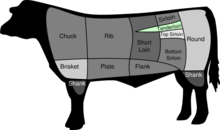Filet mignon: Difference between revisions
m typo correction - In french, 'filet' with one 'l' |
No edit summary |
||
| Line 8: | Line 8: | ||
}} |
}} |
||
'''Filet Mignon''' is a [[steak]] cut of [[beef]] taken from the [[beef tenderloin|tenderloin]], or [[psoas major]] of the |
'''Filet Mignon''' is a [[steak]] cut of [[beef]] taken from the [[beef tenderloin|tenderloin]], or [[psoas major]] of the steer or heifer. |
||
The same cut of beef can also be called: |
The same cut of beef can also be called: |
||
Revision as of 20:28, 30 September 2007
 | |
Filet Mignon is a steak cut of beef taken from the tenderloin, or psoas major of the steer or heifer.
The same cut of beef can also be called:
- French: chateaubriand, tournedos, filet de bœuf. (Note that, in France, though beef "filet mignon" exists, the word doesn't usually refer to beef, but instead to a tender and expensive cut of pork).
- English (US): Medallions, Tenderloin Steak
- English (UK & Ireland): Fillet Steak
- Argentina: Bife de Lomo
The tenderloin runs along either side of the spine, and is usually harvested as two long snake-shaped cuts of beef. The tenderloin is sometimes sold whole. If the short end of the tenderloin is cut into portions before cooking, that portion is known as Fillet Mignon, or the fillet, from the French boneless meat (mignon meaning "small" as true mignons are cut from the smaller tail end of the tenderloin).
The fillet is considered to be the most tender cut of beef, and one of the most expensive. Despite its hefty pricing, fillet mignon is ordered by many at restaurants the world over. The average cow provides no more than 4-6 pounds of filet. Because the muscle is non-weight bearing, it receives very little exercise, which makes it tender.
The fillet can be cut into 1-2 inch thick portions, then grilled and served as-is. One can also find the fillet in stores already cut into portions and wrapped with bacon.
High heat is the usual method for cooking the fillet. Either grilling, pan frying, broiling, or roasting is preferred.
Porterhouse steaks in the USA, equivalent to T-bone steaks in Commonwealth countries, are large cuts which include the fillet. The small medallion on one side of the bone is the fillet, and the long strip of meat on the other side of the bone is the strip steak—in British Commonwealth usage, only the strip steak is called the porterhouse.
